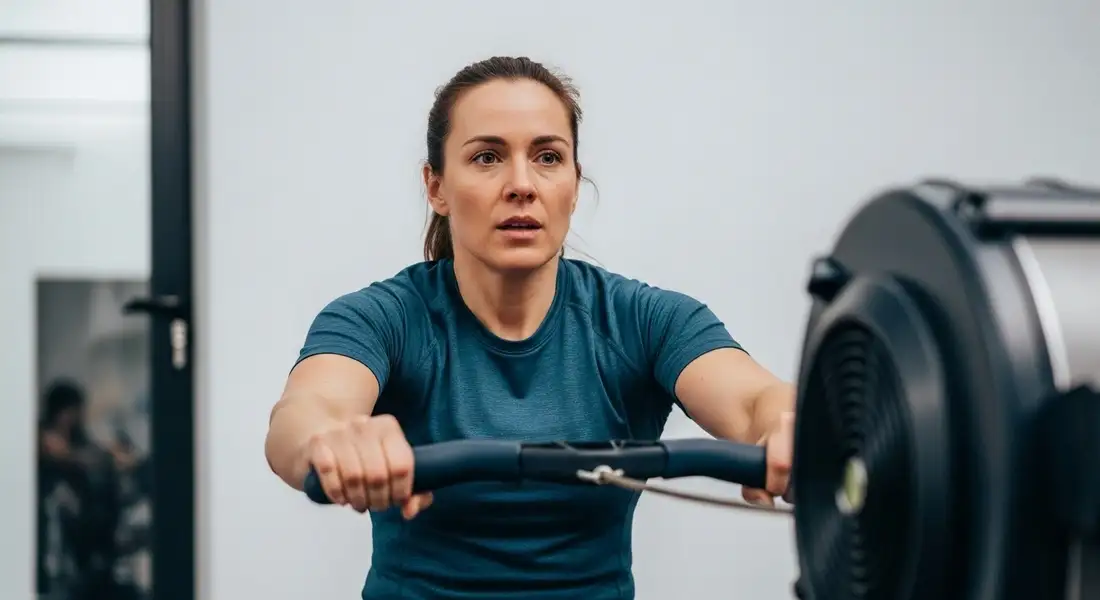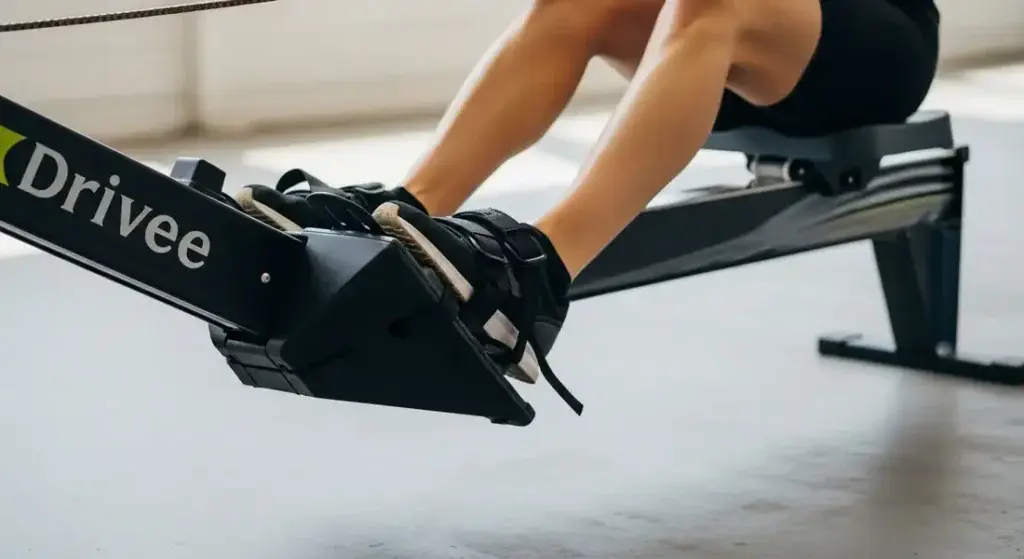Congratulations! You’ve taken the time to learn the essentials, from the types of rowing machines to mastering the four phases of proper rowing technique.
You’ve built the foundation.
Now, it’s time to put that perfect form into action and start building your engine.

This is where the motion becomes a mission – your mission for better fitness.
This guide provides simple rowing workouts for beginners designed specifically to build two key pillars of fitness: stamina (the ability to go longer) and strength (the ability to push harder).
We’ll also address common difficulties beginners face when transitioning from practicing form to performing workouts, and show you how to overcome them.
Let’s get you rowing with purpose!
Before You Start – The Beginner’s Pre-Workout Checklist
Think of this as your pre-flight check.
Getting these three things right will make your workouts safer, more effective, and easier to track.
The Essential Warm-Up (5-7 Minutes)
Never skip this! A good warm-up prepares your muscles and mind for the work ahead.
- Light Cardio (2 mins): Arm circles, leg swings, torso twists.
- Technique Drills on Rower (3-5 mins): Row very lightly, focusing on perfect form. Do 1 minute each of “legs only,” “legs and body swing,” and finally, full-slide rowing at a very gentle pace.
Understanding Your Monitor – The 3 Key Metrics
Your monitor is your coach. For these workouts, focus on three things:
- SPM (Strokes Per Minute): Your pace or rate. For beginners, a lower SPM (18-24) with powerful, well-formed strokes is better than a high, frantic SPM.
- /500m (Split Time): How long it would take you to row 500 meters at your current pace. A lower number means you’re going faster/harder. This is your best indicator of intensity.
- RPE (Rate of Perceived Exertion): How hard the workout feels to you, on a scale of 1 to 10. This is your personal guide.
Rate of Perceived Exertion (RPE) – A Beginner’s Guide
How hard the workout feels to you, on a scale of 1 to 10. This is your personal guide.
| RPE Level | Feeling / Description | Example Use |
| 1-3 | Very light activity; like a slow walk. | Warm-up / Cool-down |
| 4-5 | Light effort; can hold a full conversation easily. | Steady State Pace |
| 6-7 | Moderate effort; can speak in short sentences. | Interval “Work” Pace |
| 8-9 | Hard effort; speaking is difficult, just a few words. | Power Stroke Pace |
| 10 | All-out effort; cannot speak, unsustainable. | (Not for these workouts) |
Your Damper Setting Reminder
Remember, a high damper setting isn’t a ‘harder workout’ button.
As the experts at Concept2 explain, it’s like the gearing on a bike; it affects how the row feels, not the resistance itself.
For beginners, it’s best to keep the damper on the lower end (e.g., 3-5) to focus on good technique.
The Workouts – Your Starting Lineup

Here are four foundational workouts.
Aim to do 2-3 of these per week on non-consecutive days to allow for recovery.
Workout 1 – The Foundation Builder (Steady State Stamina)
- Goal: To build your aerobic base and stamina. This is about maintaining a consistent effort over time.
- Structure:
- Duration: 20 Minutes
- Pace:
- SPM: 20-22
- RPE: 4-5 (You should be able to chat)
- Beginner Focus: The goal here is consistency. Try to keep your /500m split time as steady as possible throughout the 20 minutes. Don’t worry about speed; worry about rhythm.
Workout 2 – The Power Primer (Intro to Strength)
- Goal: To focus on generating strength and power in your leg drive.
- Structure:
- Duration: 15-18 Minutes
- Pace:
- Row for 2 minutes at a comfortable pace (SPM 20-22, RPE 4-5).
- Then, perform 10 Power Strokes. For these 10 strokes, focus entirely on driving as hard as you can with your legs. Your SPM might go up slightly (to 24-26), but the focus is on a much lower /500m split time for those 10 strokes.
- Row for 1 minute very lightly to recover.
- Repeat this entire cycle 4-5 times.
- Beginner Focus: During the power strokes, think “LEGS!” Don’t let your form break down. It’s better to have 10 powerful but technically sound strokes than 10 frantic ones.
Workout 3 – The Interval Ladder (Stamina & Intensity)
- Goal: To introduce variety and challenge your cardiovascular system by alternating between work and rest.
- Structure:
- Duration: ~21 Minutes
- The Ladder Up:
- 1 minute “ON” (SPM 22-24, RPE 6-7)
- 1 minute “OFF” (SPM 18-20, RPE 3-4, very light recovery row)
- 2 minutes “ON”
- 2 minutes “OFF”
- 3 minutes “ON”
- 3 minutes “OFF”
- The Ladder Down:
- 2 minutes “ON”
- 2 minutes “OFF”
- 1 minute “ON”
- 1 minute “OFF”
- Beginner Focus: Pay attention to how your body feels. During the “ON” periods, you should be working hard enough that holding a conversation is difficult. The “OFF” periods are for active recovery – keep moving, but very gently.
Workout 4 – The Distance Challenge (Mental & Physical Endurance)
- Goal: To complete a set distance, a great way to benchmark your progress. We’ll start with 2000 meters.
- Structure:
- Distance: 2000 Meters
- Pace: Aim for a strong but sustainable pace (RPE 5-6).
- Strategy: Break it down mentally into four 500m pieces.
- First 500m: Settle into a strong, comfortable rhythm. Don’t go out too fast!
- Second 500m: Maintain your pace. Focus on technique.
- Third 500m: This is often the toughest part. Stay mentally strong.
- Fourth 500m: If you have energy left, slightly increase your power for the final 250m.
- Beginner Focus: Your first goal is just to finish! Note your final time. The next time you do this workout, your goal is to beat that time, even if only by a few seconds.
Common Workout Hurdles & How to Overcome Them
It’s normal to face challenges when you start training.
Here’s how to handle them.

Difficulty 1 – “I get completely out of breath and have to stop.”
- The Cause: You’re likely starting too fast or rowing at too high a stroke rate (SPM).
- How to Overcome It:
- Slow Down Your SPM: A lower SPM (e.g., 20) forces you to focus on a powerful, controlled stroke followed by a deliberate recovery. Remember, the recovery is where you breathe!
- Row to RPE, Not Speed: Pay more attention to how you feel (your RPE) than your /500m split time initially. Aim for the suggested RPE in the workout.
- Extend Your Warm-Up: Give your body more time to gradually prepare for the effort.
Difficulty 2 – “My form falls apart when I get tired.”
- The Cause: Muscular fatigue is causing a breakdown in technique, which is inefficient and risks injury.
- How to Overcome It:
- Technique is King: As soon as you feel your form slipping (e.g., hunching your back, shooting the slide), consciously slow down or ease off the power.
- Focus on One Cue: In your next workout, pick one technical element you struggle with (e.g., “straight back”) and make it your mantra.
- Shorten the Workout: It’s better to do a 15-minute workout with good form than a 25-minute one with bad form.
Difficulty 3 – “I’m not sure if I’m actually getting fitter.”
- The Cause: Without tracking, progress can feel invisible.
- How to Overcome It:
- Keep a Simple Log: After each workout, write down the date, which workout you did, and one key metric (e.g., your total time for the 2000m challenge, or your average /500m split for the steady state row).
- Notice the “Feeling”: Are you less breathless during the same workout than you were last week? That’s progress!
- Progress Your Workouts: Once a workout feels easy at the prescribed pace, it’s time to progress.
How to Progress Your Workouts
When a workout starts to feel comfortable, you can make it more challenging in one of three ways (only change one variable at a time!):
- Increase Duration: Add 5 minutes to your steady-state row.
- Increase Intensity: Aim for a slightly lower /500m split time at the same SPM.
- Decrease Rest: In interval workouts, shorten your “OFF” periods (e.g., from 1 min to 45 seconds).
FAQs – Your Workout Questions Answered
- Q1: How many times a week should a beginner do these rowing workouts?
- A: A great starting point is 2 to 3 times per week. This provides enough stimulus for your body to adapt and get fitter, while also allowing for crucial recovery days in between. Listen to your body; if you’re very sore, take an extra rest day.
- Q2: Can I mix and match these workouts during the week?
- A: Absolutely! In fact, it’s a great idea. A good weekly schedule could be: Workout 1 (Stamina) on Monday, Workout 2 (Strength) on Wednesday, and Workout 3 (Intervals) on Friday. This variety keeps things interesting and challenges your body in different ways.
- Q3: What’s more important to track as a beginner: my total time or my split time (/500m)?
- A: Both are useful, but for different reasons. Your split time (/500m) is your best real-time indicator of intensity. You should watch this during your workout to maintain a consistent pace. Your total time (e.g., for the 2000m workout) is a great metric to track progress over weeks and months. It shows you the result of all your hard work.
Conclusion – Consistency is Your Superpower
These simple rowing workouts for beginners are your starting blocks.
The most important secret to building stamina and strength isn’t a single, heroic, all-out effort. It’s consistency.
It’s showing up 2-3 times a week, focusing on good form, and patiently putting in the work.
Listen to your body, track your progress, and most importantly, celebrate the small victories. You’ve got this!
What’s your favorite type of workout? Intervals, steady state, or something else?
- Let us know in the comments if you’ve tried these routines!
Ready for More?
- Need a full overview? Head back to the main Beginners Guide to Rowing Machines.
- Want to double-check your form? Review our Mastering Basic Rowing Technique guide.
